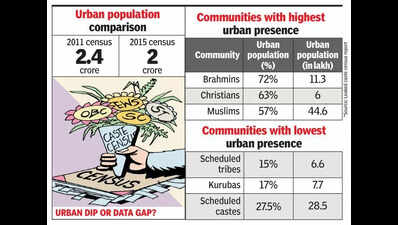- News
- City News
- bengaluru News
- Urban dip or data gap? Leaked report shows drop in urban population in Karnataka
Trending
Urban dip or data gap? Leaked report shows drop in urban population in Karnataka
Bengaluru: The leaked report of the caste census conducted by Karnataka's permanent backward classes commission in 2015 has stirred a fresh controversy over data reliability, as it indicates a surprising drop in urbanisation — contradicting national projections.
While top academic and banking institutions estimate India's urban population will grow to 40% by 2036, the leaked survey pegs Karnataka's urban population at just 34% in 2015, down from 38.7% in 2011 census data.
This apparent four percentage point drop in the urban population from 2.3 crore in 2011 to 2.04 crore in 2015 — despite only a marginal change in the total population (6.1 crore to 5.9 crore) — has raised serious doubts over the veracity of the enumeration and challenges in data collection.
Experts involved in the survey preparation said urban data collection posed the biggest hurdle. "In 2015, when the survey began, we enrolled the office of the then BBMP administrator Vijay Bhaskar to launch the same but our enumerators faced major roadblocks with urban population refusing to share any of their data," said an expert.
Another expert cited both the "closed mentality" in urban residential complexes and the fluid nature of the city population. "A large part of the population from these urban centres had either flown out of the state for employment opportunities and a lot of outsiders had entered the urban pockets in search of employment. This was primarily identified in Bengaluru. Result: There was a lot of missed data," the expert admitted.
Experts involved in the exercise have hinted that the anomalies in urban data indicate the need for updates or even amendment to some figures.
In fact, the urban population would be much higher now than what was in 2015, and even more than in 2011 and what is needed is an update as well as extrapolation of the data before making it public, they said, requesting anonymity ahead of a special cabinet meeting to discuss the report.
Despite the overall drop, the leaked data reveals a strong urban presence among certain communities.
Of Karnataka's 77 lakh Muslims, 57% or 45 lakh live in urban areas. Christians too show high urbanisation — 63% of 9.5 lakh. Among Brahmins, 72% or 11.3 lakh of 15.6 lakh live in cities. In contrast, urban SCs and STs account for 27% (28.5 lakh of 1 crore) and 15% (6.6 lakh of 42 lakh), respectively. Vokkaligas and Lingayats have 27.5% and 25% of their populations in urban areas.
The lowest urbanisation rate is found in the Kuruba community to which chief minister Siddaramaiah belongs, with just 17% (7.7 lakh of 43.7 lakh) living in cities.
GFX
Urban population comparison
2011 census
2015 survey
2.4 crore
2 crore
Communities with highest urban proportion
Community
Urban population (%)
Urban population (in lakhs)
Brahmins
72%
11.3 lakh
Christians
63%
6 lakh
Muslims
57%
44.6 lakh
Communities with lowest urban proportion
Community
Urban population (%)
Urban population (in lakhs)
Scheduled tribes
15%
6.6 lakh
Kurubas
17%
7.7 lakh
Scheduled castes
27.5%
28.5 lakh

About the Author
Sandeep MoudgalEnd of Article
FOLLOW US ON SOCIAL MEDIA








